
Black Rhino - Lion Confrontation
1st Image: This and the next 4 images depict a 14-month Black Rhino driving a lioness & other members of her pride from some nice thick grass where the young rhino wanted to graze. You may wonder why the lioness didn't simply pull down this defenseless baby rhino with its small, undeveloped horn. The presence of the mother with her large horn (3rd & 4th Images) is the major reason. Also, the lionesses' fear of having her babies (hiding in the grass-2nd Image) get trampled, and the absence of the lions, may also have contributed to her decision not to fight. Note the lioness distracting the rhino away from her cubs [Ngorogoro, Tanzania].
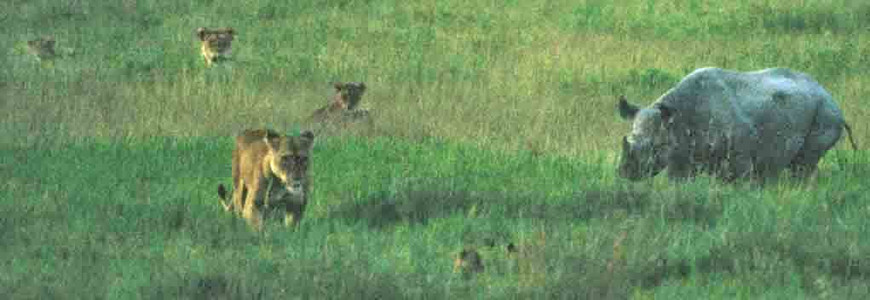
Black Rhino + Lioness
2nd Image: Black Rhino Juvenile: The 14-month-old Black Rhino driving away a lioness & the other lions. Note the small cubs hiding in the deep grass in the center-foreground and background. {Ngorogoro, Tanzania]
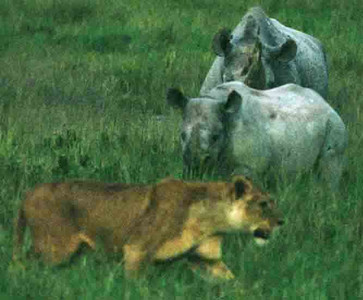
Black Rhino + Lioness
3rd Image: Black Rhino juvenile & mother.The lioness knows that the mother would use her big horns to back up her 14-month juvenile. The lioness, the only adult among the lions, is not going to take on the 2500 lb. mother rhino by herself. [Ngorogoro, Tanzania].
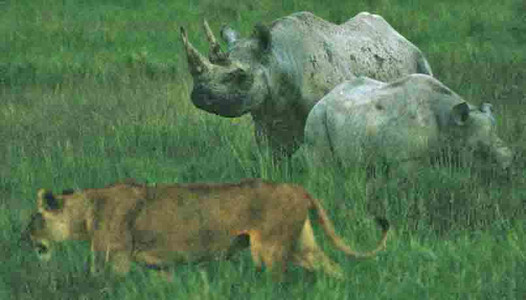
Black Rhino + Lioness
4th image:Juvenile male Black Rhino & mother is similar to the previous image, but with a better view of the mother's big horns which, in a fight, she could drive into the the lionesses' chest. [Ngorogoro, Tanzania].
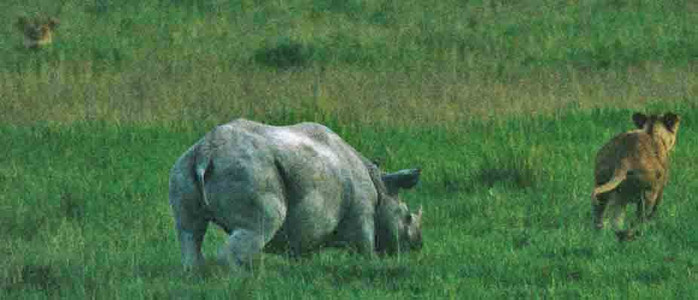
Black Rhino + Lioness
5th image: Rhino juvenile male is chasing the lioness who finally decides to take herself and her other juveniles to another area. [Ngorogoro, Tanzania]..
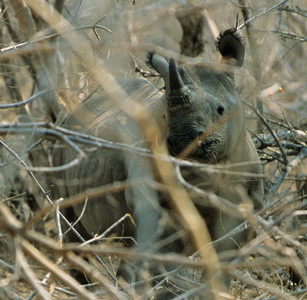
Black Rhino Female
Black Rhino female in woods: My guide & I stalked (to about 100 ft.) this black rhino pair in the woodlands. The big male (next image) was interested in mating with this female, and he chased off, with a loud grunt, a younger male who had briefly entered the scene. [Matusadona, Zimbabwe].
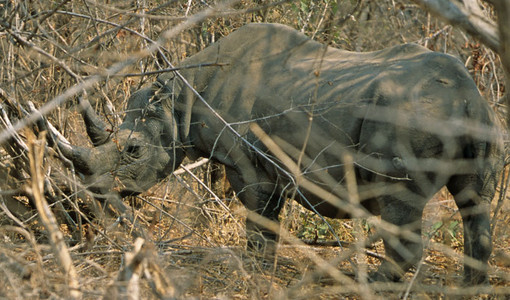
Black Rhino
This large Black Rhino male wanted to mate with the female (previous image), and had already driven off a younger male who tried to approach her. The Black Rhino is noted for its very bad disposition compared to that of the white rhino, but they can be stalked on foot because of their very poor eyesight, and cannot easily diffine stationary objects. Thus, one must be careful not to move when the animal is looking your way. To be safe, it is wise always to be close to a sturdy tree that one can readily climb should the animal decide to charge. The Rhino would come straight at you, and not be deflected by brush or small trees standing between the two of you. [Matusadona, Zimbabwe].
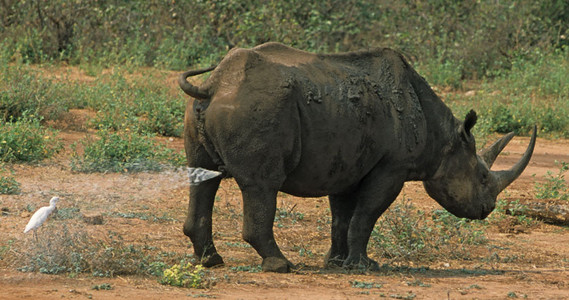
Black Rhino-1st Image
1st Image: Black Rhino male urinating. The designations 'Black' or 'White' applied to the two species have nothing to do with the normal gray color of the animal. The color is determined by the color of the mud or soil in which it was rolling. The Black Rhino's smaller lips are pointed to facilitate browsing, and the upper lip wraps around the lower to facilitate stripping leaves off bushes & shrubs, and the head is smaller than the white rhino's. The 'white' in the other species is a corruption of the Africans word for wide because of its wide, vacuum-cleaner mouth. A yellowbilled egret is taking the bath, but hoping to get some insects flying out of the grass. [Lake Karibe, Zimbabwe]. These anatomical differences are well illustrated on the following Rhino pages. SCROLL DOWN FOR MORE >> All of the following images are of the same Black Rhino doing some things that are not often seen. Here he is giving a bird (cattle egret) a 'bath'. I have never seen this before.
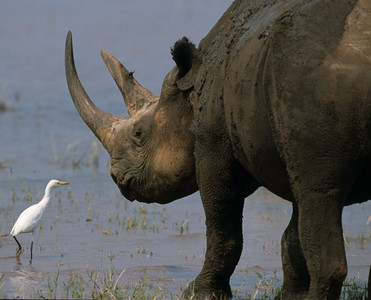
Black Rhino (2nd Image)
2nd Image A Black Rhino male at the shore (2nd Image)--not the usual habitate of a black rhino. We thought that this male was around 35 years old. Note the rounded lip (to be compared later with the vacuum-cleaner like lip of the white rhino).[Lake Karibe, Zimbabwe].
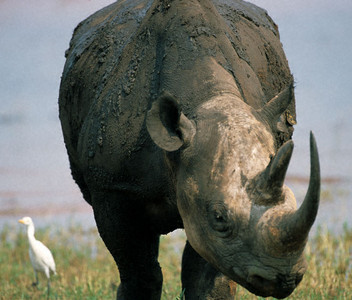
Black Rhino -3rd Image
3rd Image: This Black Rhino male at water's edge provides a very good view of the Black Rhino's rounded lip. The yellowbilled egret follows him still hoping he'll stir up some insects. [Lake Karibe, Zimbabwe].
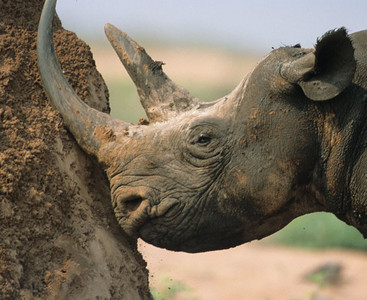
Black Rhino (4th Image)
4th image I had never before seen a Black Rhino male scratch his nose on a termite mound. Note again how the upper lip overlaps the lower one. He wraps the upper lip around a stalk of vegetation, and with a little pull of his head, wipes the leaves and fruit into his mouth. [Lake Karibe, Zimbabwe].
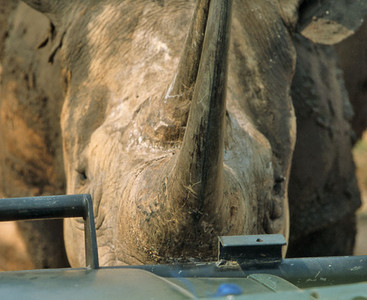
Black Rhino
5th Image: All this big Black Rhino male wanted to do was scrape clean his horn on the vehicle's brush-bar (Actually, he was very friendly--somewhat unusual for this species. Each time he made a stroke against the bar, the whole vehicle, with its 5 passengers, moved backward about a foot: some indication of his considerable strength! Note the residue of horn-scrappings where bar meets horn. [Lake Karibe, Zimbabwe].
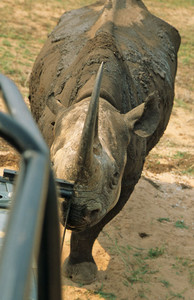
Black Rhino
6th Image: This time the Black Rhino male decided to scrape his horn on the end of the brush-bar. The pale scrapings are visible lying on the brush-bar. Again, we 5 passengers and vehicle were moved backward about a foot with each scraping. [Lake Karibe, Zimbabwe].
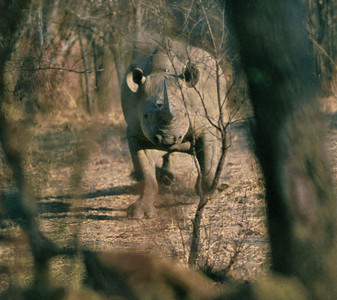
Black Rhino
The Black Rhino charged and then stopped in front of this double-trunked tree behind which I had retreated. I took advantage of the rhino's very poor eye-sight, and stood perfectly still, so that I would appear to him as part of the tree. Note the dust thrown up by his approach. I kept taking pictures, moving only my shutter-finger. After a few minutes, he snorted and retreated about 100 ft. I remained still, because I knew that he would take one last look--which he did--before disappearing into the brush. [Matopos NP, Zimbabwe]
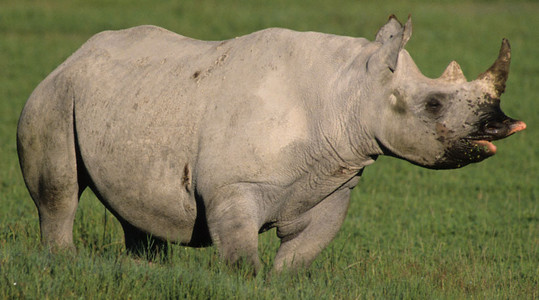
Black Rhino 1st Image
1st Image: The behavior, in this and the next image, well illustrates a Black Rhino female's dependance on her sense of smell. She is trying to figure out what the strange object--our vehicle--was. A rhino's eyesight is very poor, and so she comes closer to utilize her excellent sense of smell. Also, note that the pointed lips of this species are optimized for browsing, rather than for grazing, although this species actually does both. [Serengeti, Tanzania].
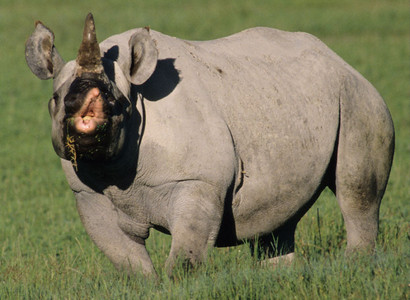
Black Rhino
2nd Image: A frontal image of the same Black Rhino female She is still trying to figure us out. I think that perhaps she is being especially careful, because she is protecting her two juveniles (shown in the next two images). [Serengeti, Tanzania].
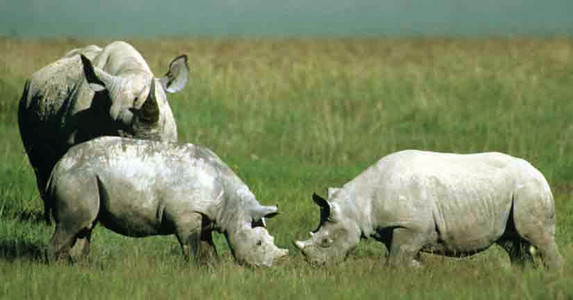
Black Rhino
3rd Image: Black Rhino mother watching her two pups playing My guestimate, from the horn development and their size, is that these two youngsters are about 6-8 months old. Without well developed horns, they would be defenseless against lions or hyenas. Their survival depends entirely on the watchfulness of their mother, and her skill in using her big horn. Their father, long gone, takes no responsibility for their rearing. [Serengeti, Tanzania].
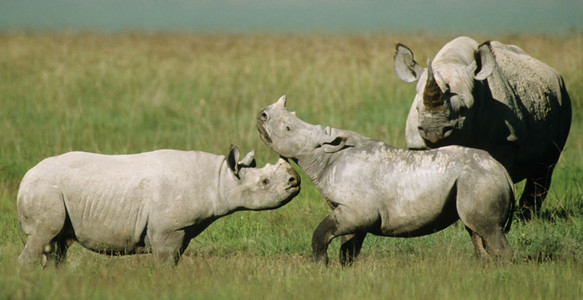
Black Rhino
The two juvenile Black Rhino's playing under the protection of their ever watchful mother (2nd Image). Same Individuals as in the previous image. [Serengeti, Tanzania].
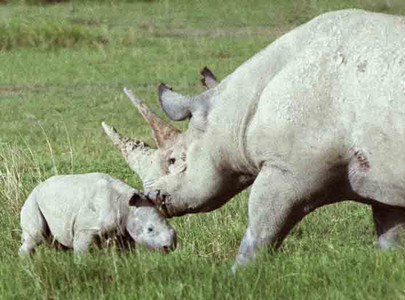
Black Rhino
Black Rhino female with her 29-day-old male Calf: (The wardens of The Crater informed us about this cub's exact age). It is the same animal as the viewer will see earlier in this series, at one year, chasing a lioness and cubs from this crater!. His birth weight was about 50 lbs.Those beautiful, well-developed horns of his mother will provide good protection. The big problem will be protecting her from poachers, because of those high-quality, commercially valuable horns. [Ngorogoro, Tanzania].
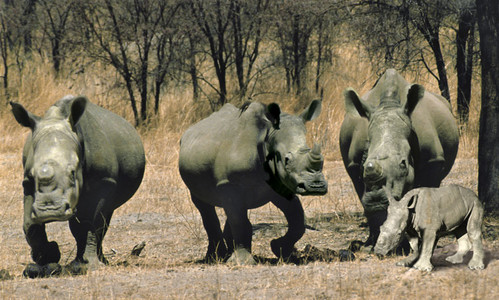
White Rhino
White Rhino-Three White Rhino adults and1Calf: The big difference between the 2 species of rhino is the shape of the head and the mouth. As previously stated, the name "White" is a corruption of the afrikaans word "waite', meaning wide. The viewer can readily see the wide mouth on these last 5 images. This species has a mouth-shape that is best suited for grass-feeding, i.e., grazing. (The curled lip of the black rhino is more suited to wiping leaves off of a branch, i.e., 'browsing'). The skin-color of the two species is actually the same. The color of the soil or mud, in which the individual has been lying, determinines the color. The White rhino is a slightly larger animal, and it has a much better disposition. The viewer will note that the horns on these adults are deformed, because they are regrowing. Horn-amputation was a failed attempt to discourage poaching, but the poachers killed those without horns anyway! Obviously, they didn't want to expend their tracking/hunting efforts on hornless individuals. [Matopos NP, Zimbabwe].

White Rhino
The White Rhino approaches three old cape buffalo bulls who were peaceably resting, but the rhino, the larger animal, came along and 'asked' them to leave--and they obliged, in leisurely fashion. [Samburu, Kenya].
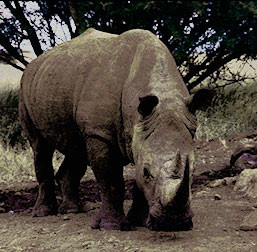
White Rhino
This was a large, friendly male White Rhino who allowed people to pet him. Note the wide mouth. Unfortunately, the government decided to move him to another park where he was not as well protected, and he was poached for his horns. Note that his color is the same as the soil on which he stands. [Private Reserve, Kenya].
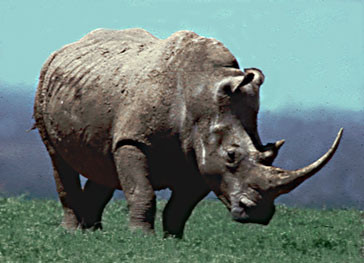
White Rhino
This adult male has a beautiful large horn and a second smaller one. (The horns are of the same substance as our fingernails). The larger, longer head and the wide mouth are an easy distinction between this species and the black rhino species. [Solio, Kenya].
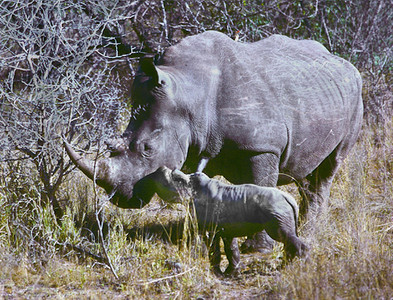
White Rhino
This is the same mother White Rhino and 4-week Infant that you will see at the water in the next image. [Sabi Sabi Marine Camp, South Africa].
White Rhino
White Rhino (F) with her young calf, and reflection: The very young calf, standing at the mother's rear, is probably only about 4 weeks old. We had seen the mother and baby in the bush where she was hiding the youngster. The female is totally responsible for feeding, protecting, and raising her young. The male leaves after mating. While we were observing the scene, two hyenas appeared and eyed the calf. The mother just stood her ground and the baby cuddled against her. As we expected, the hyenas made no aggressive move, because of the presence of the mother with her big horn. Had there been many hyenas, the fate of the calf might have been entirely different. [Sabi Sabi Marine Camp, South Africa].